
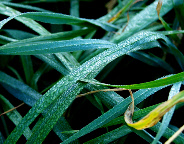
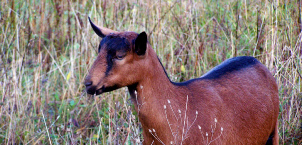
Basic Health
Signs of Health or Illness
Health is the normal state of being. Goats can get sick because of the wrong conditions, feeding, and housing. When everything is just right there is very little chance of your goats getting sick. Since health is the normal state of being, when goats are sick they act or look differently. Physical signs will normally be the first indication of a sick goat. However, in order to be able to recognize the physical signs of a sick goat, you must first closely observe your goats when they are healthy. Physical signs of sickness are the first indication of something wrong which should direct you to look for additional signs to help pinpoint the most likely problems. The more symptoms you can identify, the less likelihood you will mistreat it. Physical signs of a healthy goat are alert and inquisitive attitude, bright eyes, cool and dry nose. If you know your goats, it should be easy to pick out unhealthy animals in your herd.
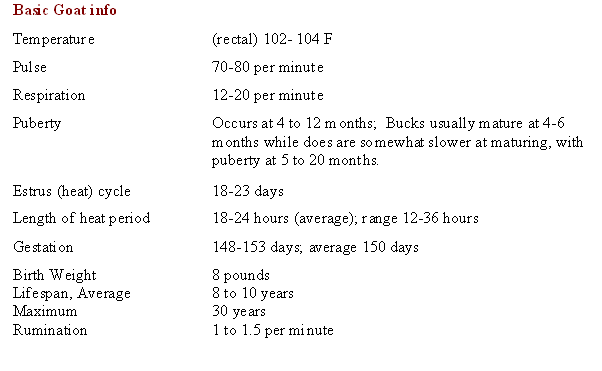
Picking your Veterinarian
Getting a good vet is very important as it may mean life or death for your goats later on. A good way to find a good vet is to ask other goat breeders in your area and see who they use and what they think. When you find a good vet, try to ask them for help or advice before desperately needing help.
Giving Injections
One day, sooner or later, you will have to vaccinate or inject antibiotics or whatever into your goats. The best way to learn how to give an injection is to watch someone else. There are many types of injections including intravenous (IV), intramuscular (IM), subcutaneous (SC), and intramammary. Always follow veterinary and manufacturer advice with injections.
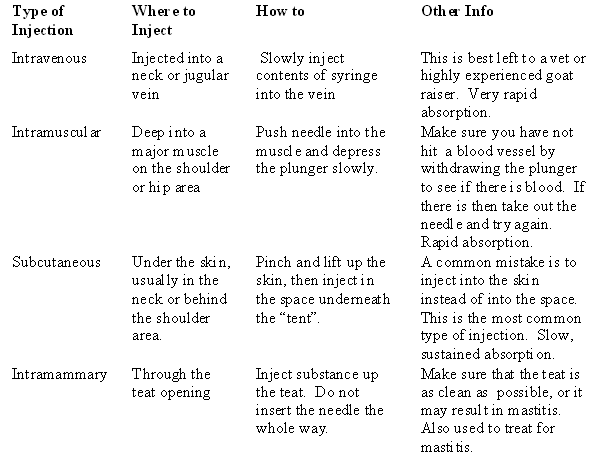
Immunizations & Vaccinations
Goats should be immunized against Enterotoxaemia and Tetanus because these diseases are very often fatal. It’s always better to have your goats protected than dead.
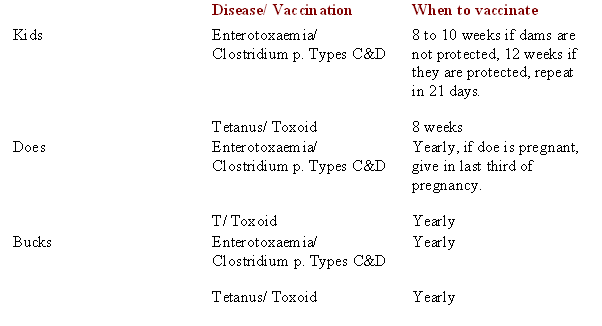
Oral Medications
Oral medication is used to treat digestive problems, diarrhea, and worms. To drench, hold the goat’s head firmly and tip it up slightly, but only very slightly as you don’t want the goat to choke. Insert the drenching tool in the side of the mouth and over the tongue. Then depress the plunger very slowly to release the contents, The goat should swallow the medicine. Another oral medication can be found in the form of a pill called a bolus. Balling guns are devices that are designed to get the bolus behind the tongue. Coating a bolus with food shortening or breaking it into halves or thirds helps to get the goat to swallow it much more easily.
Some Goat Diseases in Alphabetical Order
If your goat has a life-
Abortion
Abortion is when a goat expels a fetus prematurely. Noninfectious causes of abortion include nutrition deficiencies, plant toxins such as locoweed, and stress. Certain medications can also cause abortions, so medicate pregnant goats with caution. The best way to prevent abortion is to keep all your pregnant goats comfortable and avoid any unnecessary stress. If an abortion in your herd occurs it is always a good idea to have the fetus examined at a lab to make sure your herd is not harboring a serious disease. Many infectious agents that cause abortion are zoonotic (can cause illness in people) so please handle abort fetuses with care. Pregnant women should not handle any aborted tissues or goats that have recently aborted.
There are several bacteria that cause abortion:
Chlamydophilosis (Chlamydiosis, Enzootic Abortion): Abortion occurs late in pregnancy. Later births are normal as the doe becomes immune to the bacteria. The doe has no other side effects unless a fetus or placenta is retained. This bacterial infection, caused by Chlamydia psittaci, is very contagious and can often affect an entire herd. Tetracycline drugs given intramuscularly for five to seven days help reduce the spread of the organism. The best cure is prevention. Remove and bury all fetuses and clean up all fluids as well as isolating the doe.
Leptospirosis: see leptospirosis
Brucellosis: see brucellosis
Coxiella burnetii Infection: This bacteria comes from wild rodent populations. It
is a zoonotic disease that causes Q fever in humans. Late-
Listeriosis: see listeriosis
Abscess
An abscess is a lump or boil filled with pus caused by the body reacting to an infection. It grows until it bursts and exudes a thick pus. Abscesses can be caused by wounds, punctures, and needles. Another more serious cause could be Caseous Lymphadenitis, or CL, which is a very contagious disease. The problem with CL is that it is very difficult to treat and often internal abscesses form along with the exterior abscess. Interior abscesses can include organs and kill the goat. If you suspect CL, isolate the animal. All milk from the goat should be discarded as abscesses can form in the udder. Treatment for abscesses is varied because of the many different causes. Always call your vet for advice on treating your animals.
Arthritis
Arthritis is inflammation of joints. It is often found in goats that have not had their hooves trimmed regularly. The untrimmed hooves place strain on the tendons, which eventually weaken. Arthritis can also be caused by CAE, abscesses, and many kinds of bacteria. Signs of arthritis are puffiness of joints and pain. To prevent arthritis in your herd, purchase stock with sound bones, trim feet regularly and test for CAE.
Bloat
Bloat is acute indigestion and is not as commonly seen in goats as it is in cattle
and sheep. It is the excessive accumulation of little gas bubbles in the rumen.
Because of the bubbles small size, the goat is unable to belch and relieve the pressure.
Extreme cases can be fatal. Signs of bloat are a distension of the left flank,
where the rumen is located, and the goat gasping and looking miserable. Bloat
usually occurs from a sudden change in feed, such as a large increase in grain or
a new source of green legume. A simple treatment of bloat is administration of Bloat
Medicine or 1 cup of oil. Always remember to remove the underlying cause of bloat,
such as the Extra feed. Mild cases of bloat do not require treatment as long as goats
continue to ruminate.
In extreme cases of bloat, a veterinarian will pass
a tube into the stomach to release the pressure. If this is unsuccessful, it may
be necessary to make an incision at the peak of the rumen between the last rib bone
and the point of hip and then held open.
Broken Bones
When goats break bones they usually break leg bones. Several causes include car accidents, a rope wrapped around a leg, or a leg getting caught in a gate. Whatever the cause, your goat may suddenly become very lame, the leg may be dangling, sometimes the bone is sticking right up against the skin or actually sticking out of it. Call the vet immediately. He/she should apply a plaster cast or splint. These methods work especially well with kids. Check the cast or splint twice daily and keep the cast dry. Broken bones, though serious usually heal perfectly if proper care is taken.
Brucellosis
Brucellosis is caused by a bacterium called Brucella melitensis. It is also the cause of Malta fever in humans. The incidence of this disease in the United States is extremely low. The organism causes abortion in the fourth month of pregnancy. Arthritis can also develop. There is a vaccine available but is not necessary unless the disease is found in your herd.
Caprine arthritis and encephalitis (CAE):
This disease is caused by a lentivirus. The infection is believed to spread from mother to kid through infected milk. The best prevention is raising kids in pasteurized milk and routinely testing and removing infected animals from the herd.
In kids, the symptoms start with a weakness in the rear legs at about
two to four months old. The disease progresses so that kids cannot rise. They usually
remain alert, eat well, and have no fever. However, they eventually lose muscle
strength and eventually die. In older animals, the disease begins with swollen joints
and arthritis to the point where the animal can no longer die. Only a small percentage
of goats with CAE show any symptoms. Animals who test positive can still be kept
as long as they are kept away from clean animals and their kids are bottle-
Caseous Lymphadenitis (Pseudotuberculosis):
This common abscess disease is caused by a small gram-
Abscesses should be lanced or removed by a veterinarian. Infected animals should be isolated. A vaccine can be made from infected goats to inoculate uninfected goats. Antibiotics can also help reduce the bacteria but is usually not effective as the walls of the abscess prevent movement. CL can be very difficult to eradicate as the bacteria is found in the soil but is not impossible. All water buckets and feeders should be cleaned to prevent transmission if the bacteria.
Enterotoxaemia:
This disease is caused by the bacterium clostridium perfringens types C and D. Type C is known as lamb/kid dysentery, while type D is known as pulpy kidney disease. Syptoms include tooth grinding, twitching, convulsions, and death within a few hours. Kids are usually found dead. Type C usually affects very young kids and older goats while type D usually affects young animals.
The bacteria is normally found in the intestines, but sudden changes in feed can cause the bacterial population to grow releasing toxins. The toxins are extremely poisonous. Antibiotics can stop the growth of the bacteria but only antitoxins will stop the released toxins.
Animals should be routinely vaccinated against enterotoxemia. However, vaccination alone will not prevent losses. Always change feed gradually. If you must change feeds completely, do so over the course of at least three weeks.
External Parasites:
Lice: Lice cause itchiness and flaking. In severe cases, goats can develop anemia
due to the loss of blood. Lice are host-
Goat Scabies: Caused by an infestation of Chorioptes caprae. The mites are very rare in dairy goats. Symptoms include severe itchiness and loss of hair on the legs and belly. Scabby masses then from where hair has been lost. The mites are easily seen under the microscope. Pesticide solution should be used as treatment.
Mange: This illness is also caused by mites. Sarcoptic mange usually affects the neck, face, and belly. Clip the affected area then wash with a mange remedy. Demodectic mange causes small pustules to form, usually around the flanks and udder. Clean the affected areas with hydrogen peroxide.
Ringworm: this disease is caused by a fungus that leaves a crusty circle. It can be treated by Removing the crust and treating with iodine two to three times a week. The fungus can affect humans so be careful to wash your hands after handling sick goats.
Foot Rot:
Symptoms include lameness, a bad odor, and broken sides of the hoof. Wet soil
encourages the spread of bacteria. Keep hooves trimmed and the barnyard well-
Foot Rot is caused by two bacteria; fusobacterium necrophorum and fusiformus nodosus. Neither organism causes the disease alone. F. necrophorum can also cause foot abscesses above the hoof causing inflammation and pain. Antibiotics usually eliminate this problem.
Goat Pox:
Symptoms include runny nose, red eyes, fever, lack of appetite, and poor hair coat. As the illness progresses, lumps form all over the goat’s body. Scabs will from on the lumps and leave pockmarks if removed. The goat finally develops pneumonia. All cases of goat pox must be reported to agricultural authorities. There is no effective treatment, but there is a vaccine available for problem areas. This is a very fatal disease as the mortality rate reaches 80%.
Internal Parasites:
It is always a good idea to have a fecal sample from a sick goat. That way you can have a good idea of what treatment to pursue.
Coccidiosis: This illness is caused by a tiny parasite, eimeria, that lives in the intestines. Oocytes are passed in the feces and can contaminate pasture and water. Symptoms include loss of appetite, diarrhea, dull appearance, and straining. These symptoms can range from mild to severe. It mostly affects young kids. Good sanitation and isolation of sick animals will keep an infection from spreading. There are several dewormers available for coccidiosis available, but will not help unless the goat’s environment is kept clean. Effective drugs: Amprolium, Sulfa Drugs
Flukes or Flatworms: The most common of these parasites is the liver fluke. They are large parasites that live in several parts of the digestive system. Symptoms include poor growth, bottle jaw, anemia, and sometimes sudden death. Effective drugs: Albendazole, Fenbendazole.
Strongyles: Symptoms include anemia, bottle jaw, diarrhea, and decreased milk production. These are very common in goats. Goats should be dewormed often.
Tapeworm: These are long, flat worms. They are visible when passed through the feces. They are easily treatable. Effective Drugs: Fenbendazole, Mebendazole.
Toxoplasmosis: This is a coccidia like organism that is passed from cat feces. Prevent cats from having access to goat feeds and water.
Johnes Disease (Paratuberculosis, Wasting Disease):
This disease is caused by the bacterium mycobacterium paratuberculosis avium. The disease is usually seen in animals from three to five years old. Symptoms include weight loss, dull coat, loss of appetite, and diarrhea. There is no treatment for this disease. Prevention includes raising kids on pasteurized milk and buying healthy stock.
Listeriosis (Circling Disease):
Listeriosis is caused by the bacterium Listeria monocytogenes. The bacterium is found in many animals and birds. It is spread when the goat gets the bacteria in its eyes, or swallow or inhale it. Symptoms include circling in one direction, high fever, lack of appetite, red tissues around the eyes, and facial paralysis. In another form of the disease, the goat aborts with no other side effects.
A common source of the disease is improperly kept food or silage, or sudden increases
in grain. There are no effective treatments for this disease. Large doses of penicillin
may help. Animals who are already circling rarely live past twenty-
Malignant Edema:
Malignant Edema is caused by Clostridium septicum, which causes gas gangrene in contaminated wounds. Symptoms are a swollen and infected wound on an animal, accompanied by high fever and lack of appetite. The bacteria produces a toxin that destroys the tissue surrounding the wound. Death can occur within two days if enough tissue is destroyed.
Edema should be treated with antibiotics. The best prevention is cleanliness and treating injuries promptly. This bacterium can affect humans, so wash your hands after touching infected animals.
Mastitis:
Mastitis is the inflammation of the mammary gland. Symptoms include heat, swelling, and pain. There are several organisms that can cause mastitis so a milk test is a cheap and inexpensive way to pinpoint the exact bacterium. The California Mastitis Test (CMT) is also an inexpensive way of testing for subclinical mastitis (no symptoms exist).
Gangrenous Mastitis: This kind of mastitis produces a cold and black udder. It usually kills the doe, and even if she recovers, the udder is destroyed. Treat with penicillin or ampicillin.
Most cases are caused by staphylococcus spp., cornyebacterium spp., and streptococcus spp. There are several intramammary infusions available to treat mastitis. Penicillin and Tetracyclines should be used. As well as antibiotics, does with mastitis should be milked often (at least three times a day) and kept in a clean, isolated pen.
Most mastitis cases are caused by poor milking practices. Proper sanitation and gentle treatment of the udder can prevent mastitis. Never drink milk from infected animals.
Milk Fever (Hypocalcemia):
Milk Fever is a metabolic disease where a doe is unable to release calcium stored in her bones to produce milk. When the doe uses all the calcium from her bloodstream she shows symptoms including wobbly gait and depression. This disease occurs in goats right before kidding. Treatment is to give inject 25% calcium borogluconate solution. For prevention, feed the doe a low calcium diet in the last month of pregnancy. See ppp I made.
Pink Eye (Infectious Keratoconjunctivitis):
Pink eye can be caused by many different bacteria. Symptoms include swelling of the eyelids, squinting, cloudy cornea, and sometimes ulcers on the cornea. Treatment consists of Injecting antibiotics or using eye ointment. Keep infected goats away from the herd as pink eye can be very contagious.
Polioencephalomalacia (Cerebrocortical Necrosis):
Goat Polio is caused by thiamine (vitamin B1) deficiency. Goats usually receive enough thiamine from the rumen but toxins and enzymes from molds can destroy the thiamine before it can be absorbed by the goat. Goats stargaze, twitch, circling, teeth grinding, blindness, and the head pulled back to the side.
This disease is more common in young fast-
Pneumonia:
In goat herds, pneumonia is primarily due to improper ventilation and stress to the lungs allowing bacteria, and in some cases lungworms, to multiply. Symptoms are runny nose, coughing, and labored breathing. Sick goats should be treated with tetracyclines or long acting sulfamonides. Goats should also be in a warm, ventilated place in order to recover. Prevention includes keeping humidity in buildings low and keeping barns uncrowded with proper ventilation.
Poisonous Plants:
Symptoms of poisoning are vomiting, frothing, trembling, convulsions, labored breathing. If you think a goat has been poisoned, induce it to vomit by placing salt on the back of the tongue.
Goats raised in confinement are more susceptible to plant poising than other goats
because they have less experience for dangerous plants. Plants to be avoided are
nightshades, locoweeds, nitrate-
Pregnancy Toxemia (Ketosis)
Ketosis is a metabolic illness that occurs within the last few weeks of pregnancy. Common symptoms include loss of appetite, spastic motion, twitching ears and inability to stand. Labored breathing, coma and death can result. The symptoms resemble those of milk fever and may initially respond to treatment for milk fever but will then relapse. To prevent ketosis, provide a balanced diet with no quick changes.
It is caused when does rapidly break down body fat to provide food for the growing
embryos. The break down produces ketones, a toxic by-
Sore Mouth:
Sores form around the mouth, eyelids, and teats. Treat the sores by cleaning them and applying antibiotic ointment if needed. A vaccine is available if it is a problem in a herd. However, once a goat has had sore mouth, it becomes immune to that strain.